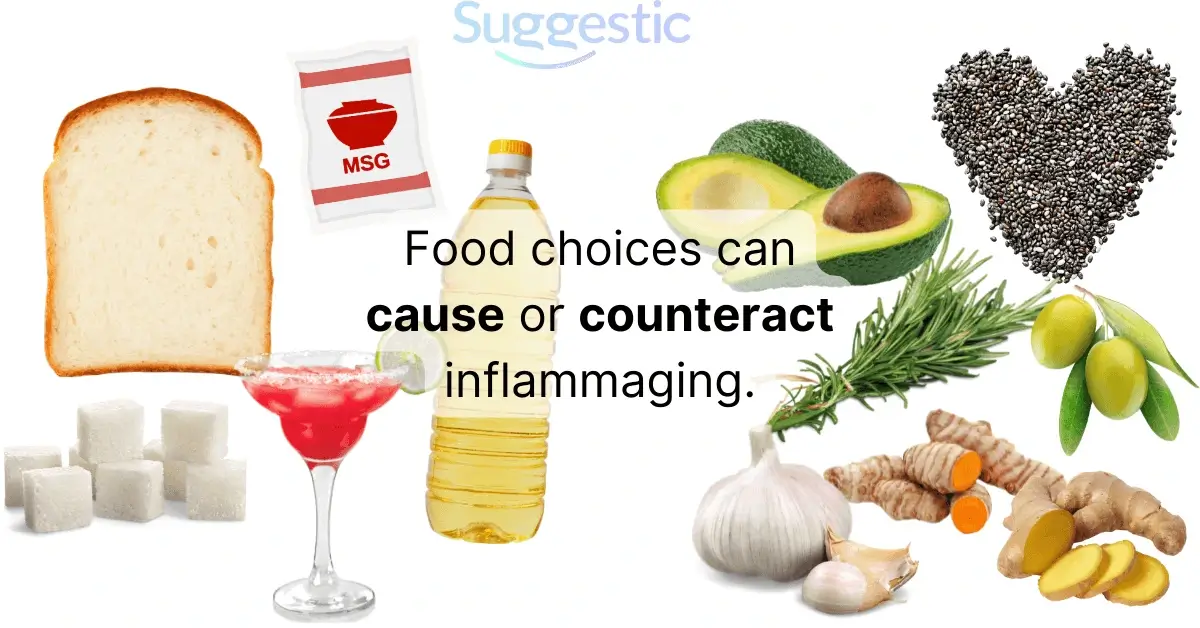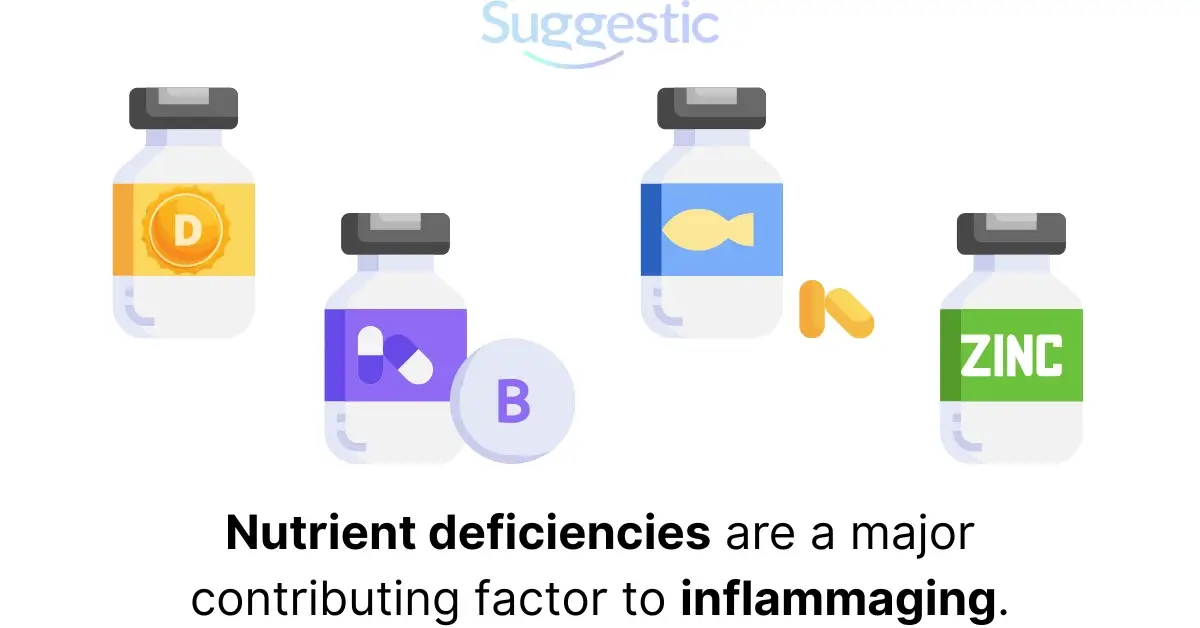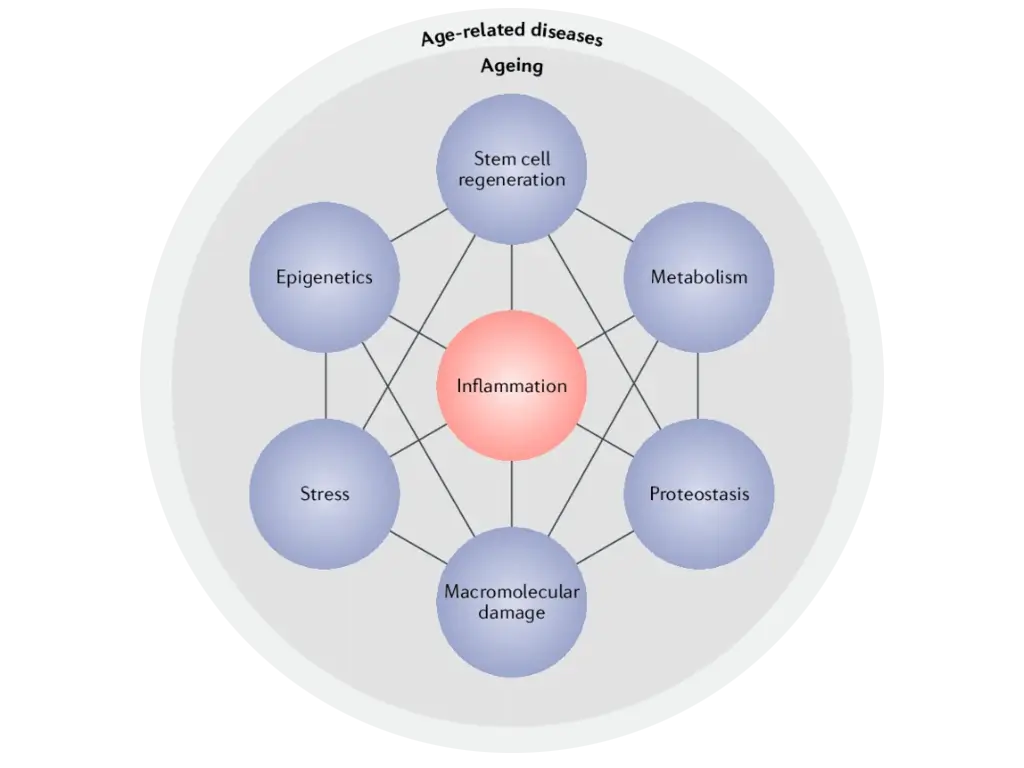Different processes of slowing and breaking down occur in the body as it ages, and one of the most prevalent reasons for this is inflammaging. Inflammaging is an age-related increase in pro-inflammatory response and the result of long-term, low-grade inflammation.
This post will explore how diet and supplements affect inflammaging, look at which biomarkers can be measured to track inflammaging, and finally, cover some natural methods of countering or slowing down the process of inflammaging.
What is inflammaging?
Inflammation can be good, and it can be bad. It’s good when it’s needed for the body to fight off an acute infection or injury. And it’s bad when it’s the kind of inflammation that lurks in the background over an extended period. That is called chronic inflammation.
Chronic inflammation can speed up the process of aging and lead to cognitive and physical disability, frailty, and overall premature mortality.[1] It has not yet been proven whether inflammation is the driver for aging or aging is the driver for inflammation. It is clear, however, that regulating and lowering chronic inflammation with healthy lifestyle choices is predictive of longer vitality and better cognitive functions.[2]
Symptoms of inflammaging
While acute inflammation visually manifests as fever, swelling, or local redness, low-grade chronic inflammation is harder to notice. It can be discovered by measuring specific biomarkers (more on that later). But since inflammation is so tightly connected with practically all known chronic health conditions, its symptoms include:
- bone and muscle loss
- weakness and loss of strength
- weight and fat gain
- memory problems and mood swings
- muscle and joint pains
- body aches
- digestive issues
- blood sugar fluctuations
- frequent illness and injuries
- fatigue and low energy
Nutrition plays a significant role in the process of inflammaging
Inflammatory foods
Diet plays a major role in inflammaging.[3] Many commonly consumed foods in the standard American diet are highly inflammatory and should be avoided or minimized to prevent accelerated aging and progression of age-related diseases. These include:
- refined sugar and carbohydrates
- highly processed vegetable and seed oils
- artificial food ingredients, such as artificial sweeteners, MSG (monosodium glutamate), and some artificial food dyes[4]
- food additives and preservatives
- conventional processed meats[5]
- alcohol
The good news is that as much as food can be harmful, it can also be incredibly healing. But more on that later.

Insulin resistance
Blood sugar imbalances are another contributor to the development of inflammaging.
Eating (too much) sugar typically leads to a spike in an individual’s blood glucose levels. In a healthy person, the body will respond to this by releasing insulin, a hormone that bring glucose levels back to normal. If the sugar spikes occur too often, however, the body will become numb to insulin, and the blood sugar levels will start rising. This process is called insulin resistance.
One study discovered insulin resistance is closely linked to an increased inflammatory response in the body.[6] Another study found strong connections between diabetes, stress, and elevated inflammation levels.[7]
Nutrient deficiencies
Too much food (hypercaloric nutrition) speeds up inflammaging but so does too little of essential nutrients.[8] The following four nutrients are critical for healthy aging.

Vitamin D
42% of Americans are deficient in vitamin D.[9] This is not good news since this group of vitamins is responsible for many vital bodily functions, such as absorbing essential minerals and supporting the immune system.
Low levels of vitamin D in the body are associated with chronic pain, mood issues, depression, fatigue, muscle weakness, high blood pressure, and susceptibility to frequent illnesses (such as cold and flu). A recent study shows that vitamin D supplementation in individuals with deficient vitamin D levels leads to an improvement in chronic inflammation.[10]
B vitamins
Vitamins from the B group are essential for brain health, an area highly affected by inflammaging. Supplementing can maintain healthy brain function, cellular health, mental health, nerve function, and digestion.[11] Pregnant and breastfeeding women are especially susceptible to B-complex deficiencies, as well as people following vegan or vegetarian diets.[12]
Omega-3 fatty acids
The right ratio of omega-6 and omega-3 essential fatty acids is essential for keeping a balance in the body and reducing inflammation. The ideal ratio for omega-6 to omega-3 is anywhere from 4:1 to 1:4, while the current standard in the Western diet is closer to 15:1.[13]
Omega-3 supplementation in older individuals has also been proven to improve inflammation.
Zinc
Zinc is a trace mineral that is only needed in a small amount but is essential for the body’s vital functions – the creation of DNA, growth of cells, healing of damaged tissues, and supporting the immune system. One study found that a zinc deficiency contributes to inflammaging and deterioration of the immune system with age.[14]
Other inflammaging causes
- chronic stress
- poor sleep
- lack of exercise
- environmental toxins
- chronic infections (mold & yeast, Lyme disease, viral infections, bacterial toxins)
- undiscovered allergies (such as gluten or casein intolerance)
Biomarkers to track inflammaging
As mentioned in the introduction, chronic inflammation does not manifest visually. So even though you might be noticing symptoms, it’s a good idea to measure specific blood markers to assess the presence and extent of inflammaging.
This is an extensive topic, but let’s quickly look at some commonly used biomarkers for testing inflammation:
- fasting insulin & hemoglobin A1C can recognize elevated blood sugar levels, insulin resistance, and blood sugar balance problems – all indicative of inflammation
- high-sensitivity C-reactive protein measures the protein produced in the liver that goes up with inflammation
- homocysteine – higher levels of this amino acid are directly related to age-related inflammation, and inflammatory diseases such as arthritis[15]
- ferritin levels increase during inflammation (to decrease bacterial growth of iron), therefore they are a useful indicator of the level of inflammation
- red blood cell width tests for underlying inflammation by looking at the size of red blood cells – larger red blood cells can be associated with sarcopenia, an inflammaging-related issue[16]
Methods to naturally counter inflammaging
Anti-inflammatory diet
After eliminating or minimizing pro-inflammatory foods, replacing them with anti-inflammatory, nutrient-dense foods is important.
Foods that have been proven to reduce chronic inflammation include whole vegetables and fruits, spices such as ginger and turmeric, herbs such as sage, basil and rosemary, bone broth, apple cider vinegar, avocados and avocado oil, coconut oil, olives and extra virgin olive oil, wild-caught fish and grass-fed meat, fermented foods, garlic, and onions.
Here are some nutritional superstars:
- berries contain anthocyanins which have anti-inflammatory effects[17]
- fatty fish such as salmon, mackerel, and anchovies (preferably wild-caught) for their omega-3 fatty acid content
- cruciferous vegetables (broccoli, kale, brussels sprouts) contain many antioxidants that, among other benefits, decrease levels of cytokines[18]
- green tea with EGCG, a compound known to reduce cytokine production[19]
Intermittent fasting
Intermittent fasting is a helpful technique for reducing chronic inflammation by improving the microbiome, insulin resistance, and cellular autophagy. It simply means cycling between periods of eating and fasting. Many believe this kind of eating is more adapted to human physiology than constant snacking. The fasting period can be anywhere between 12 and 16 hours, with the eating hours respectively 12 to 8 hours.
Botanical supplements
It can sometimes be hard to eat a large enough amount of certain food for its anti-inflammatory compounds to have a noticeable effect on the body. That’s why certain phytochemicals (plant-produced chemicals) can be ingested as a supplement.
- curcumin – the active compound in turmeric – is one of the most well-researched active plant ingredients, known to not only significantly reduce inflammation but also relieve pain in conditions such as joint arthritis[20]
- resveratrol – a natural phenol found in the skin of grapes, some berries, peanuts, and red wine – has a high antioxidant activity and lowers inflammation[21]
- quercetin – a flavonoid found in citrus fruits, apples, onions, herbs, tea, and red wine – can be beneficial for the immune system and lowering inflammation[22]
Conclusion
Aging is inevitable. Again, the question about whether inflammation is responsible for aging or vice versa is like the chicken and egg debate. However, it has been shown repeatedly that making healthy and informed lifestyle choices can greatly attenuate bodily malaises, physical, and cognitive decline.
The information on the Suggestic website is provided for informational purposes only and with the understanding that Suggestic is not engaged in rendering medical advice or recommendations. These statements have not been evaluated by the Food and Drug Administration. This information is not intended to diagnose, treat, cure, or prevent any disease.
References
| 1 | Ferrucci, L. and Fabbri, E. (2018). Inflammageing: chronic inflammation in ageing, cardiovascular disease, and frailty. Nature Reviews Cardiology, 15(9), pp.505–522. doi:10.1038/s41569-018-0064-2 |
|---|---|
| 2 | Patrick, R. (2019). Inflammation as a biomarker of successful aging — evidence in semi-supercentenarians. [online] FoundMyFitness. Available at: https://www.foundmyfitness.com/episodes/inflammation-successful-aging |
| 3 | Franceschi, C. et al. (2018). Inflammaging: a new immune–metabolic viewpoint for age-related diseases. Nature Reviews Endocrinology, [online] 14(10), pp.576–590. doi:10.1038/s41574-018-0059-4 |
| 4 | Manuel, R. (2021). Chronic Gut Inflammation Might be Triggered by Two Common Food Coloring. [online] Science Times. Available at: https://www.sciencetimes.com/articles/31181/20210514/chronic-gut-inflammation-triggered-two-common-food-coloring.htm [Accessed 28 Aug. 2022] |
| 5 | Chai, W. et al. (2017). Dietary Red and Processed Meat Intake and Markers of Adiposity and Inflammation: The Multiethnic Cohort Study. Journal of the American College of Nutrition, [online] 36(5), pp.378–385. doi:10.1080/07315724.2017.1318317 |
| 6 | Rehman, K. and Akash, M.S.H. (2016). Mechanisms of inflammatory responses and development of insulin resistance: how are they interlinked? Journal of Biomedical Science, 23(1). doi:10.1186/s12929-016-0303-y |
| 7 | Wellen, K.E. (2005). Inflammation, stress, and diabetes. Journal of Clinical Investigation, 115(5), pp.1111–1119. doi:10.1172/jci200525102 |
| 8 | Franceschi, C. et al. (2018). Inflammaging: a new immune–metabolic viewpoint for age-related diseases. Nature Reviews Endocrinology, [online] 14(10), pp.576–590. doi:10.1038/s41574-018-0059-4 |
| 9 | Barkley, C. (2021). The power of vitamin D: What experts already know (and are still learning) about the ‘sunshine vitamin’ – UTHealth News – UTHealth. [online] www.uth.edu. Available at: https://www.uth.edu/news/story.htm [Accessed 28 Aug. 2022] |
| 10 | Gonçalves de Carvalho, C.M.R. and Ribeiro, S.M.L. (2016). Aging, low-grade systemic inflammation and vitamin D: a mini-review. European Journal of Clinical Nutrition, 71(4), pp.434–440. doi:10.1038/ejcn.2016.177 |
| 11 | Kennedy, D. (2016). B Vitamins and the Brain: Mechanisms, Dose and Efficacy—A Review. Nutrients, [online] 8(2), p.68. doi:10.3390/nu8020068 |
| 12 | Healthline. (2018). B-Complex Vitamins: Benefits, Side Effects and Dosage. [online] Available at: https://www.healthline.com/nutrition/vitamin-b-complex |
| 13 | Ap, S. (2002). The Importance of the Ratio of omega-6/omega-3 Essential Fatty Acids. [online] Biomedicine & pharmacotherapy = Biomedecine & pharmacotherapie. Available at: https://pubmed.ncbi.nlm.nih.gov/12442909/ |
| 14 | Ticinesi, A. et al. (2016). Nutrition and Inflammation in Older Individuals: Focus on Vitamin D, n-3 Polyunsaturated Fatty Acids and Whey Proteins. Nutrients, 8(4), p.186. doi:10.3390/nu8040186 |
| 15 | Wu, J. (2007). Circulating Homocysteine Is An Inflammation Marker And A Risk Factor of Life-Threatening Inflammatory Diseases. J Biomed Lab Sci, [online] 19(4). Available at: https://www.labmed.org.tw/upfiles/issues/20091222114147.pdf |
| 16 | Kim, J. (2018). The Association between Red Blood Cell Distribution Width and Sarcopenia in U.S. Adults. Scientific Reports, [online] 8(1). doi:10.1038/s41598-018-29855-z |
| 17 | Joseph, S.V. et al. (2014). Berries: Anti-inflammatory Effects in Humans. Journal of Agricultural and Food Chemistry, 62(18), pp.3886–3903. doi:10.1021/jf4044056. https://pubmed.ncbi.nlm.nih.gov/24512603/ |
| 18 | Hwang, J.-H. and Lim, S.-B. (2014). Antioxidant and Anti-inflammatory Activities of Broccoli Florets in LPS-stimulated RAW 264.7 Cells. Preventive Nutrition and Food Science, [online] 19(2), pp.89–97. doi:10.3746/pnf.2014.19.2.089 |
| 19 | Molina, N. (2015). Green tea polyphenols change the profile of inflammatory cytokine release from lymphocytes of obese and lean rats and protect against oxidative damage. International Immunopharmacology, [online] 28(2), pp.985–996. doi:10.1016/j.intimp.2015.08.011 |
| 20 | Daily, J.W. et al. (2016). Efficacy of Turmeric Extracts and Curcumin for Alleviating the Symptoms of Joint Arthritis: A Systematic Review and Meta-Analysis of Randomized Clinical Trials. Journal of Medicinal Food, [online] 19(8), pp.717–729. doi:10.1089/jmf.2016.3705 |
| 21 | de Sá Coutinho, D. et al. (2018). Anti-Inflammatory Effects of Resveratrol: Mechanistic Insights. International Journal of Molecular Sciences, [online] 19(6), p.1812. doi:10.3390/ijms19061812 |
| 22 | Li, Y. (2016). Quercetin, Inflammation and Immunity. Nutrients, [online] 8(3), p.167. doi:10.3390/nu8030167 |




